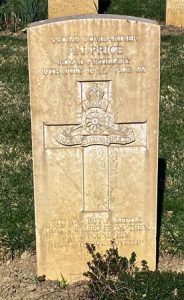Llangenny is a village in the historic county of Breconshire, which lies within the Brecon Beacons National Park, in the lower reaches of the Grwyne Fawr and a mile east of Crickhowell. The area is very popular today with tourists, especially walkers and cyclists. The men of Llangenny who fell during both World Wars are commemorated on a relatively modern war memorial, which is situated in Crickhowell near the site of the old War Memorial Hospital. The memorial commemorates the men of Crickhowell and District who fell during both World Wars and in the Iraq War and is divided up between the villages.
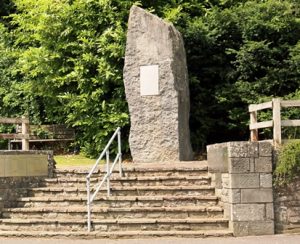
The Great War, 1914-1918
Herbert Philip Gordon Cochran, DSO, Lieutenant Colonel, Middlesex Regiment. Herbert was born at Sandhurst on 6 April 1877, the son of Captain Francis Cochran and Alexandrina Cochran (nee Kelland). His parents were both Scottish: his father from Aberdeen, and his mother from Edinburgh. Herbert’s mother died two weeks after his birth and Herbert was raised by his grandmother, Alexandrina Kelland, at Aston, Birmingham, as his father was a career minded officer. Herbert followed in his father’s footsteps, gaining a commission as Second Lieutenant into the Middlesex Regiment as a young man. He served during the Boer War of 1899-1902 with the 2nd Battalion, Middlesex Regiment. Herbert remained in the army over the coming years, then on 28 September 1911 married Agnes Mary Rees, of Penydarren Park, Llangenny. Herbert, now a Captain, was appointed as Adjutant to the 9th Battalion, Durham Light Infantry in January 1914. He embarked for France on 19 April 1915 with one of the Territorial Battalions of the Durham light Infantry and over the coming years was promoted to Major. Herbert was awarded the French Croix-de-Guerre and the Distinguished Service Order in the 1918 New Year’s Honours List. He was promoted to Lieutenant-Colonel in February 1918 and given command of the 15th Battalion, Cheshire Regiment, which was in the Ypres Salient, in the Houthulst Forest area, attached to 105 Brigade, 35th Division. On 9 March 1918 the 35th Division moved out of the Ypres Salient and entrained at Rousbrugge for France, detraining at Mericourt-L’Abbe on 23 March before marching to positions around Suzanne, in the Somme valley. By now the Allies were in trouble. The Germans had launched an overwhelming offensive along a stretch of the Western Front running south from Croisilles to La Fere on 21 March 1918 and had destroyed almost everything in their path as they drove forwards towards Albert and Amiens. As Herbert led his battalion forwards to Maricourt on 24 March 1918, in support of the beleaguered front-line troops, they immediately came under enemy fire and ferocious fighting ensued around the village of Clery-sur-Somme. Herbert was posted as missing during the fighting that day and was later deemed to have been killed in action. The remains of the 40-year-old were later discovered and buried on the battlefield, but after the war his grave was exhumed and he was re-interred in Delville Wood Cemetery, Longueval, France. His half-brother, Captain Lionel Francis Cochran, was killed in Egypt in 1915. In June 1919 a bronze memorial plaque in his memory was unveiled in Llangenny Church.
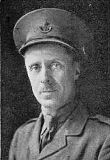
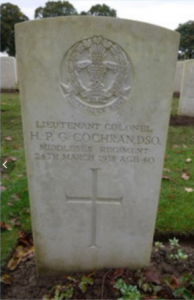
Albert Valentine Davies, Second Engineer, Mercantile Marine. Albert was born in 1886, the son of Howell Davies and Bridget Davies (nee Price), of Pen-y-Rhiw Farm, Llangenny. His father died when he was just six years old, and his mother moved the family to Newport. Albert left home as a young man, to train as a Motor Engineer at Cardiff, and lodged at 23, Hamilton Street, Cardiff. He enlisted into the Mercantile Marine as a Second Engineer soon after the outbreak of war and was posted aboard the London registered steamer, SS Livonia. On 3 December 1917, Livonia was en-route from Bilbao to the Tyne with a cargo of iron ore, when she was torpedoed and sunk by the German submarine UB-35, some four miles off Start Point. Albert was among 23 lives lost in the sinking. The 31-year-old has no known grave and is commemorated on the Tower Hill Memorial, London.
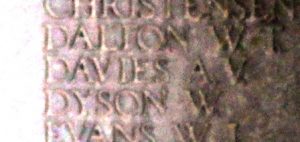
Richard Thomas Mann, Private, 1435, Monmouthshire Regiment. Richard was born at Abergavenny on 14 December 1896, the son of PC Thomas Mann and Beatrice Mann (nee Day). His father appears to have died by 1901 and in 1903 his mother married John Watkins, before the family moved to Llangenny. Richard had begun work as a printer’s apprentice with his step father at Llangenny prior to the war. He enlisted at Abergavenny into the 3rd Battalion, Monmouthshire Regiment (Territorial Army) on 6 February 1913 and attended his first annual TA summer camp at Porthcawl later that year. Richard was mobilised with the 3rd Battalion, Monmouthshire Regiment soon after the outbreak of war. He died not embark for France with the battalion when it sailed for France on 14 February 1915 but remained with the reserve battalion until being drafted out among a large number of reinforcements on 27 June 1915, following such losses to the battalion during the Second Battle of Ypres that it had been forced to merge temporarily with the 1st and 2nd Monmouth’s. Soon after joining the battalion, Richard was shot in the groin on 25 August 1915 and severely wounded. He was treated at the 85th Field Ambulance, where his wounds were dressed, before being sent to the 2nd Casualty Clearing Station, then to the 8th CCS before being sent by hospital train to the 1st Canadian General Hospital at Étaples. He was then taken aboard the Hospital Ship Brighton and evacuated to England. Whilst recovering in hospital at Sheffield, he started to suffer from bouts of coughing and was found to have contracted tuberculosis. Richard was discharged from the army as medically unfit on 8 May 1916 and returned home to Abergavenny, where he died from a combination of his wounds and tuberculosis on 1 June 1917. The 20-year-old was buried in Abergavenny Old Cemetery. He is also commemorated on the Abergavenny war memorial.
David Sidney Morris, Private, 1901, Monmouthshire Regiment. David was born at Llangenny in 1894, the son of David Morris and Sarah Anne Morris. His parents were from Shropshire, but had moved to 4, New Road, Llangenny after his father had gained work there as a farm labourer. By 1911 the family had moved to Derri Cottage, Mardy, Abergavenny, where his father had gained a position as a farm bailiff. David worked as a grocer’s carter after leaving school. He enlisted at Abergavenny into the 3rd Battalion, Monmouthshire Regiment soon after the outbreak of war. The battalion mobilised at Abergavenny attached to the Welsh Border Brigade, Welsh Division, before moving to Pembroke Dock. On 10 August 1914 the Division moved to Oswestry before moving to Northampton, then spent Christmas at Bury St. Edmunds before moving to Cambridge. In February 1915 the 3rd Monmouth’s left the Welsh Division and landed in France on 14 February, before moving to the Ypres Salient. On 3 March 1915 the battalion joined 83 Brigade, 28th Division. On 8 April the 3rd Monmouth’s relieved a French Division in the sector east of the Polygon Wood to begin its first tour in the trenches. The battalion was relieved four days later, and marched to billets in Ypres, then on 17 April relieved the 5th King’s Own in the front line, to begin a spell which would last for 17 days without relief. On 22 April, just to the north, the Germans launched the first gas attack of the war upon French Colonial troops at Gravenstafel, heralding the opening of the Second Battle of Ypres. The fighting remained to the north of Polygon Wood until 3 May, when the Germans widened their attacks and the Polygon Wood sector was evacuated by the 28th Division, which fell back on the G.H.Q. line at Potijze. David had been killed in action on 2 May 1915, just prior to the evacuation. The 20-year-old has no known grave and is commemorated on the Ypres (Menin Gate) Memorial, Belgium. David is commemorated on the Abergavenny war memorial but is not commemorated at Llangenny.
Arlingham George Pocock, Leading Signalman, J3362, Royal Navy. Arlingham was born on 13 February 1893, the son of George Henry Pocock and Maud Elizabeth Pocock (nee George), of Glangrwyney, Llangenny. He worked as a telegraph messenger after leaving school, then on 13 February 1911 enlisted into the Royal Navy. Arlingham was posted to HMS Impregnable for training as a signaller, before receiving a posting to HMS Vivid I for further training. Over the coming years he enjoyed several more postings, then on 30 May 1917 was posted aboard the sloop, HMS Anchusa. She had been built by Armstrong Whitworth and Company, Walker on Tyne, and was launched on 21 April 1917. After commissioning, Anchusa commenced operations with the Second Sloop Flotilla out of Buncrana. On 16 July 1918 she was operating off the west coast of Ireland when she was torpedoed and sunk by the German submarine U-54, with the loss of 78 of her crew of 100 men. Arlingham was among the dead. The 24-year-old has no known grave and is commemorated on the Plymouth Naval Memorial, Devon.
Charles Powell, Private, 3739, Monmouthshire Regiment. Charles was born in 1896, the son of Enoch and Ellen Powell, of Yew Tree Cottage, Llangenny. He enlisted into the 3/3rd Battalion, Monmouthshire Regiment on 24 January 1916 and joined the battalion at Oswestry, where it was attached to the Welsh Reserve Brigade. Charles had not been at Oswestry for long when he took ill and he was hospitalised at Prees Heath Military Hospital, near Whitchurch. Sadly, he died of pneumonia there on 16 May 1916. The remains of the 19-year-old were brought home and he was buried three days later in St. David’s Churchyard, Llanddewi Rydderch.
Edgar Powell, Private, 43053, Welsh Regiment. Edgar was born at Llangenny in 1889, the son of James Powell and Frances Powell. He married Nellie Davies in 1910 and the couple set up home at Hildersley, Ross-on-Wye. Edgar enlisted into the Welsh Regiment during the summer of 1915 and was drafted to France early in 1916, joining the 2nd Battalion, Welsh Regiment, which was in the Loos sector, attached to 3 Brigade, 1st Division. The battalion was rebuilding following heavy losses during the Battle of Loos and in the subsequent actions of the Hohenzollern Redoubt the previous year and was holding the line in the South Maroc sector at Loos. On 22 June 1916 the 2nd Welsh was relieved from the line and went into billets at Le Brebis, to undergo a series of training courses. Edgar was undergoing a training course in the use of the new Mills hand grenades, when he was killed during an accidental explosion on 3 July 1916. The 27-year-old is buried in Bully-Grenay Communal Cemetery, British Extension, France. Edgar is not commemorated on the Llangenny war memorial.
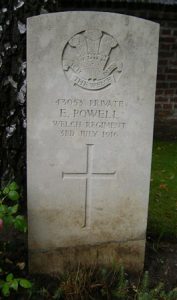
William John Powell, Private, 235398, Royal Welsh Fusiliers. William was the eldest son of William Powell and Mary Jane Powell (nee Gittoes), of Scethrog, Bwlch. He worked as a gardener prior to enlisting into the Brecknockshire Battalion, South Wales Borderers at Brecon on 11 November 1914. William was then posted to the 2/1st Brecknocks. The battalion left Brecon for Dale, in Pembrokeshire in April 1915 to join the Milford Haven garrison, then at the end of 1915 moved to Bedford to join the 68th (2nd Welsh) Division. In November 1916 the battalion was absorbed by the 2/7th Battalion, Royal Welsh Fusiliers at Wrentham, near South Wold, and moved to Benacre Camp, Wrentham. William married Jane Palliser, the daughter of Thomas and Jane Palliser of Mount Pleasant, Llangenny, whilst home on leave on 10 March 1917. He embarked for France at Southampton on 16 June 1917 and after disembarking at Rouen, was posted to the 14th Battalion, Royal Welsh Fusiliers, which was attached to 113 Brigade, 38th (Welsh) Division. William joined the battalion at Ypres on 8 July, as it was undergoing training for the forthcoming Passchendaele offensive. On 31 July 1917 the Division launched its famous assault on the Pilckem Ridge, capturing Iron Cross and reaching its objective of the Steenbeek, then played a supporting role in the Battle of Langemarck. The Division was transferred to the Sailly-sur-la-Lys sector in September and remained in the area over the winter before being moved to positions north of Albert, at Bouzincourt Ridge, at the end of March 1918, relieving the battered 2nd and 47th Divisions. It held this sector, again carrying out minor operations and trench raids, over the coming months. On 1 May 1918 the 14th RWF moved into reserve positions at Hedauville, before taking over a section of the front line that afternoon, to begin a routine tour in the trenches. William was killed in action here on 8 May 1918, probably whilst on an RE working party. The 26-year-old was buried in Martinsart British Cemetery, France. William is not commemorated on the Llangenny war memorial.
Charles James Saunders, Sergeant, 200476, South Wales Borderers. Charles was born in 1893, the son of William Saunders and Elizabeth Saunders (nee Pugh), of 4, Bridge Row, Llangenny. He served an apprenticeship as a carpenter prior to the war. Charles enlisted at Brecon into the Brecknockshire Battalion, South Wales Borderers soon after the outbreak of war and was posted to the 2/1st Brecknocks. The battalion left Brecon for Dale, in Pembrokeshire in April 1915 to join the Milford Haven garrison. Charles embarked for Aden with a large draft of reinforcements to join the 1/1st Brecknocks in the summer of 1916 and arrived there on 3 July, just as the battalion was enduring a torrid time, on a forced march across the desert which saw several men die of heatstroke. In August 1915 the battalion moved to India on garrison duties, where it remained for the rest of the war. Charles took ill during the autumn of 1918 and died of influenza at Mhow on 25 October 1918. The 25-year-old was buried in Mhow New Cemetery, India, but is also commemorated on the Kirkee 1914-1918 Memorial, India.
William Smith, Private, 3512, South African Infantry. William was born in 1878, the son of Thomas Smith and Ann Smith (nee Jones), of 17, Bridge Street, Llangenny. His father died the following year, so Ann had to raise her five children alone. William left home as a young man and eventually settled in South Africa. He enlisted in South Africa into the 3rd Regiment, South African Infantry soon after the outbreak of war. The 3rd Regiment had been raised from the Transvaal and then Rhodesia, as part of the 1st South African Brigade of the South African Expeditionary Force, and many of its recruits had previous military experience. After formation, the 3rd Regiment departed Cape Town on a number of ships between 28 August and 17 September 1915 and sailed for Great Britain, before moving to Bordon Camp in Hampshire to undergo training. On 30 December 1915 the South Africans boarded ships in Devonport and sailed for Egypt, taking part in the Senussi Campaign, but in the spring of 1916 the 1st South African Brigade was transferred to France, moving to the Steenwerck sector for trench initiation and training in the trenches at Le Bizet. In June the South Africans moved out of the line and by 18 June had reached Heilly, in the Somme valley. Over the coming days the South Africans moved forward into the battle area towards Maricourt, moving into the front line at Stanley Avenue on 4 July. The South Africans did not join the fight immediately but over the coming days supplied working parties around Bernafay Wood as other units carried the fight. On 14 July orders were received to advance and to attack Delville Wood. The fight for Delville Wood became one of the fiercest battles of the Somme campaign and raged from 14 July until 3 September. William was killed in action during the fighting for the wood on 20 July 1916, during an attempted relief of the South Africans by the 10th Battalion, Royal Welsh Fusiliers, in an action which saw two Welshmen awarded the Victoria Cross. The 36-year-old has no known grave and is commemorated on the Thiepval Memorial, France. Strangely the CWGC show the date of his death as 1 August 1916, but by now the South Africans had been relieved at last and were in huts at Fresnicourt recovering from their ordeals.
George Francis Wilband, Private, 55285, Royal Fusiliers. George was born at Basingstoke in 1882, the son of John Wilband and Jane Phyllis Wilband (nee Stidworthy). He became a gamekeeper as a young man and moved around the country several times. By 1901 he was working at Borreaton Park, Baschurch, Shropshire, and in 1903 married Anne Haycock, a domestic servant at Borreaton Hall. The couple had moved to Lower Cockleford, near Cheltenham by 1911 and then moved to Crickhowell after George had gained the position of Head Gamekeeper for Colonel Robert Preston Sandeman, at Dan y Parc, Crickhowell. George enlisted at Brecon into the Army Service Corps soon after the outbreak of war. He was subsequently transferred to the 7th Battalion, Royal Fusiliers, which was at Falmouth. The battalion landed at Le Havre on 24 July 1916, to join 190 Brigade, 63rd (Royal Naval) Division. The Division, as its name suggests, was originally formed of Royal Naval units which had been created from the surplus of sailors and adapted for service as infantry. It had taken part in the fall of Antwerp, then fought throughout the Gallipoli campaign in 1915 before moving to France in May 1916 and taking part in the Battle of the Somme. By April 1917 the Division was at Arras, and fought at the Second Battle of the Scarpe, where it captured Gavrelle. The Division then fought at the Battle of Arleux, before moving north to Ypres in October, to take part in the Second Battle of Passchendaele, the final assaults against Passchendaele Ridge. On 28 October 1917 the 7th Royal Fusiliers relieved Hawke Battalion in the front-line on the ridge, to begin its first tour in the Ypres trenches. George was killed in action on the following day, 29 October 1917, when the Divisions trenches were hit by a ferocious German artillery bombardment. The 35-year-old is buried in Dochy Farm New British Cemetery, Belgium. He left his widow and four young children.
World War Two, 1939-1945
Owen Powell Evans, Lance Corporal, 2327822, Royal Corps of Signals. Owen was born in 1920, the son of William Evans and Annie Gwenllian Evans (nee Powell), of Golden Grove, Llangenny. He had left home as a young man to enlist into the Royal Corps of Signals and was posted to I Corps Signals, embarking for France with the BEF in 1939, following the invasion of Poland by Germany on 1 September 1939. The BEF assembled on the Franco-Belgian border from 3 October onwards, with I Corps being the first into position, and held positions alongside the French on the Maginot Line. Belgium and Holland, being neutral, were left unguarded, but unfortunately this allowed the Germans to bypass the Maginot Line when they launched their Blitzkrieg in May 1940, forcing the BEF to withdraw towards Dunkirk to avoid being encircled. Owen was killed in the Ypres Salient on 27 May 1940, during the withdrawal of I Corps towards Dunkirk. The 19-year-old is buried in Strand Military Cemetery, Belgium, next to the historic Ploegsteert Wood.
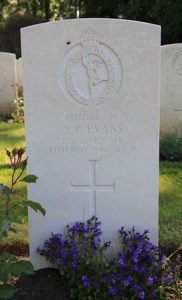
James Alfred Knight, Serjeant, T/234886, Royal Army Service Corps. James was born on 17 November 1906, the son of Alfred James Knight and Eleanor Jane Knight (nee Powell), of Pentre Quarry, Llanthewy Rydderch. His mother died just two years later, so James was raised by his grandparents. He married Frances Mabel Hill in 1933 and the couple set up home at Morfa Cottage, Llangenny, where two children, Margaret and Anthony, were born over the coming years. James enlisted into the Royal Artillery soon after the outbreak of war, but was later transferred to the Royal Army Service Corps. He died on active service in Yorkshire on 2 November 1943. The remains of the 37-year-old were conveyed home and he was buried in Abergavenny New Cemetery. Sadly, his widow, Frances, died in 1947, leaving their two children orphaned.
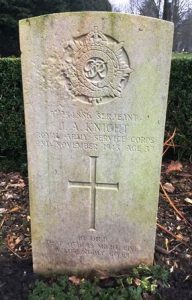
Arthur James Price, Bombardier, 880122, Royal Artillery. Arthur was born on 8 October 1920, the son of Arthur George Price and Mary Anne Price, of Llangenny. He enlisted into the Royal Artillery soon after the outbreak of war and was posted to the 300th Independent Anti-Tank Battery, Royal Artillery. The battery had been formed on 1 August 1941 from men pulled from the 57th (East Surrey) Anti-Tank Regiment, and sailed for Egypt in May 1942, to join the fight against the Afrika Korps. After a year of hard fighting, the Afrika Korps surrendered and the Allies turned their attention to driving the Germans out of Italy, which had now surrendered. Arthur’s regiment landed at Sicily on 10 July 1943 and began the arduous fight to help clear the island of its German occupiers, taking part in fighting to the south of Mount Etna. On 19 July 1943 the regiment was advancing as part of a mobile column through a mountain pass south of Agira when it was ambushed by German trench-mortar fire. Arthur was killed by a mortar shell that day, together with Lieutenant Turner and Gunner Belcher of his unit. The 22-year-old was originally buried where he fell, alongside Turner and Belcher, but in June 1944 his grave was exhumed and Arthur was re-interred in Catania War Cemetery, Sicily, Italy.
